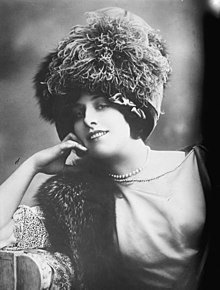Geraldine Farrar
| Geraldine Farrar | |
|---|---|
 |
|
| Born |
Alice Geraldine Farrar February 28, 1882 Melrose, Massachusetts, U.S. |
| Died | March 11, 1967 (aged 85) Ridgefield, Connecticut, U.S. |
| Occupation | Opera singer, film actress |
| Years active | 1901–1922 |
| Spouse(s) |
Lou Tellegen (married 1916–1923) |
Geraldine Farrar (February 28, 1882 – March 11, 1967) was an American soprano opera singer and film actress, noted for her beauty, acting ability, and "the intimate timbre of her voice." She had a large following among young women, who were nicknamed "Gerry-flappers".
Farrar was born Alice Geraldine Farrar in Melrose, Massachusetts, the daughter of baseball player Sidney Farrar, and his wife, Henrietta Barnes. At 5 she began studying music in Boston and by 14 was giving recitals. Later she studied voice with the American soprano Emma Thursby in New York City, in Paris, and finally with the Italian baritone Francesco Graziani in Berlin. Farrar created a sensation at the Berlin Hofoper with her debut as Marguerite in Charles Gounod's Faust in 1901 and remained with the company for three years, during which time she continued her studies with famed German soprano Lilli Lehmann. (She had been recommended to Lehmann by another famous soprano of the previous generation, Lillian Nordica.). She appeared in the title roles of Ambroise Thomas' Mignon and Jules Massenet's Manon, as well as Juliette in Gounod's Roméo et Juliette. Her admirers in Berlin included Crown Prince Wilhelm of Germany, with whom she is believed to have had a relationship beginning in 1903.
After three years with the Monte Carlo Opera, she made her debut at the New York Metropolitan Opera in Romeo et Juliette on November 26, 1906. She appeared in the first Met performance of Giacomo Puccini's Madama Butterfly in 1907 and remained a member of the company until her retirement in 1922, singing 29 roles there in 672 performances. She developed a great popular following, especially among New York's young female opera-goers, who were known as "Gerry-flappers". Farrar created the title roles in Pietro Mascagni's Amica (Monte Carlo, 1905), Puccini's Suor Angelica (New York City, 1918), Umberto Giordano's Madame Sans-Gêne (New York, 1915), as well as the Goosegirl in Engelbert Humperdinck's Königskinder (New York, 1910), for which Farrar trained her own flock of geese. According to a New York Tribune review of the first performance, "at the close of the opera Miss Farrar caused 'much amusement' by appearing before the curtain with a live goose under her arm."
...
Wikipedia
